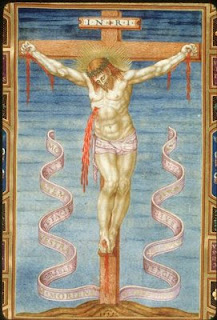+ There is never really an inappropriate time to think of the Passion of our Lord.
The saints frequently meditated on the Passion of Lord, no matter what the liturgical season. Of course, during penitential seasons, especially Lent, they entered more deeply into the mysteries of our Lord's Passion and death.
What is a bit out of the ordinary is listening to the Passion chanted outside of Lent. I figure, as long as we can still meditate on our Lord's Passion, why not help yourself better enter into that meditation with at least the last part of the Good Friday chanting of the Passion? Here is a little video I threw together of some paintings, chiefly by Fra Angelico (copyright permitted for purposes of private use and/or education), and a few other famous artists (works open to the public), with the end of the Passion. I'm not sure if the priests want their names made public, so I will omit their names here. As you will see in many of these paintings (of the ones that are Fra Angelico), St. Dominic Guzman makes a 'cameo'. He is entering into the Passion in his meditation, as we join him in our contemplation.
Disclaimer: The images don't exactly go with the words, but I realize many won't even know what is being said, unless you follow it with your Bible or missal. (I actually plan on redoing this at a later date to correct this, but I need more time to do the research for images that I can actually use within their copyrights.) Also, this particular recording was not professional, as you will notice. I had planned on going to another Good Friday Mass (in Latin) but had a friend use my recorder for this purpose, as I knew the priests that night had very good chant discipline and voices. My friend figured out where to best place the recorder towards the end of the Passion. I had to edit out where the quality was too poor, and you can hear at the beginning of this portion that the digital recorder is suddenly finding a new 'home'.
If you follow along with your missal or Bible, you will see that this recording begins with, "Partiti sunt vestimenta mea sibi: et in vestem meam miserunt sortem." ("They have parted My garments among them, and upon My vesture they have cast lots.") The Gospel continues from that point to the end of the reading, "they laid Jesus becauase the speulcher was night at hand."
Two interesting points to make here, especially if you've never attended the Good Friday traditional, "Extraordinary" Liturgical, Roman Catholic Rite. The first is you will hear a significant pause in the chanting of the Passion, as everyone (priests, laity, etc.) kneel after, "...He gave up the ghost." This is because this isn't merely a reading, or a performance, but the Holy Word of God, and our purpose in worship is meditate on the Word during the liturgy. There is much that could obviously be said here, in the context of this point of the Passion alone. The second interesting point is that at the point where the Gospel text reads, "And after these things Joseph of Arimathea..." and forward, the music suddenly modulates. Not only does it modulate, but a melodic motif is introduced and repeated as if on a loop. The melodic phrase ascends to a higher note, and falls back down and then repeats. This deliberately gives the impression of winding, as it points musically to the winding of the sudarium around the corpse of Jesus. This is particularly interesting, since this is a very, ancient melody, and if you don't know of how important the sudarium and it's link to the Shroud of Turin is, it is highly recommended that you read about it.
Without further adieu (or apologies), I bring you this video for your contemplation:
